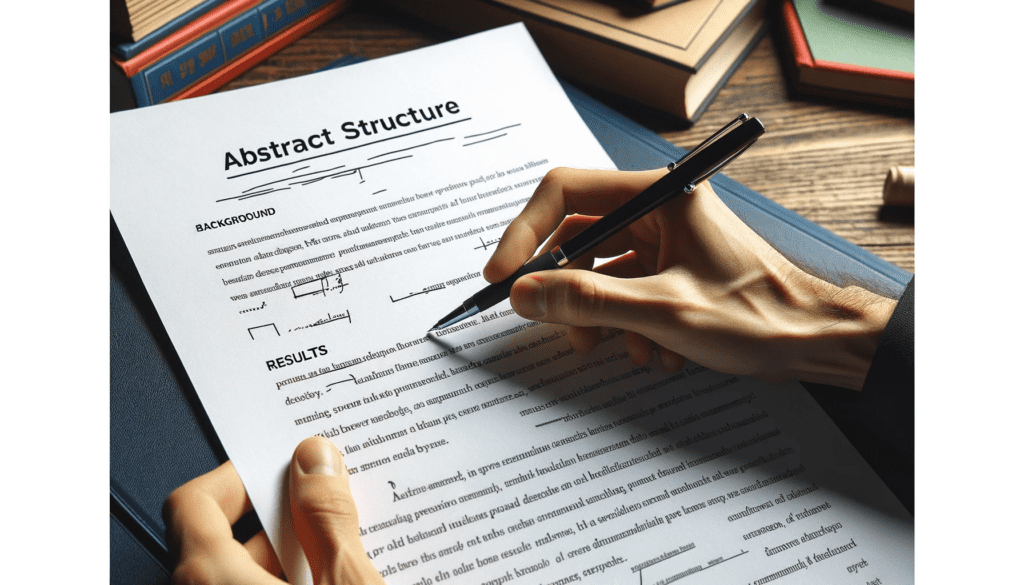Writing an effective abstract is essential for sharing your academic work with others. A well-written abstract serves as a concise summary of your study, enticing readers and authors to continue to the full paper.
This article will outline a simple formula to craft abstracts that successfully introduce your research clearly and compellingly. I’ll also provide annotated examples illustrating what makes an abstract impactful.
With the right strategy, you can master the art of abstract writing and add this vital scholarly skill to your repertoire.
The Standard Structure of an Academic Abstract

Most journal article abstracts follow a standard structure conveying key information about the paper. While specific requirements vary across disciplines, an abstract typically contains:
Background – The opening sentence(s) establish the broad context of the research. What issue or problem does the study address?
Literature – A brief synthesis of current knowledge based on the scholarly literature. What does existing research say?
Gap Statement – A statement of the specific gap, contradiction, or open question in the literature that the research aims to address.
Objectives – The primary purpose or goals of the research are stated clearly.
Methods – A brief overview of the data, samples, procedures, approaches, etc. used in the study.
Results – A summary of the study’s main findings, including key data points and statistics.
Conclusions – A discussion of the implications and significance of the research within its field.
Let’s look at excerpts from a theoretical abstract to see these elements come together.
Setting the Background in Research Abstracts
Your abstract’s opening sentence(s) should briefly introduce the broad context around your research topic. This helps readers understand why the issue merits study.
For example:
Obesity poses one of the greatest public health challenges of the 21st century, demanding effective policy and population-level interventions. However, the consumption of sugar-sweetened beverages remains high, with a mean intake of 22 gallons per person per year among U.S. youth.
This background clearly establishes why the researchers decided to focus on sugar-sweetened beverages – it is a major driver of the obesity epidemic.
When setting context, avoid being overly broad. Ground your study in the specific gap it aims to fill.
Conveying the Current State of Literature
After introducing the general problem, the next part of an abstract reviews existing knowledge based on the scholarly literature. Succinctly convey the gist of current research.
For example:
While sugar taxes have emerged as a common policy strategy globally, conflicting findings from previous studies offer limited guidance for projecting the impacts of recently adopted sugar-sweetened beverage taxes in U.S. cities.
This excerpt summarizes the key tension in the literature that motivates the study – uncertainty around how new local taxes in the U.S. will affect consumption.
Aim to synthesize key points from the literature rather than listing multiple studies. Identify research limitations, disagreements, and gaps that justify your work.
Clarifying the Gap Statement
With the current state of the literature established, the next critical element is clearly stating the specific gap or open question your research seeks to address. This gap statement justifies the need for your study.
For instance:
However, no studies to date have quantified the impacts of Philadelphia’s beverage tax on both beverage purchases and consumer substitution patterns among residents.
This statement spotlights the precise gap in existing knowledge that this study was designed to address, demonstrating the original contribution to the field.
Make your gap statement as specific as possible to carve out an original niche for your work.
Stating the Research Objectives
The objectives briefly explain the aims of your study based on the gap identified. What questions is your research trying to answer?
For example:
Therefore, this study sought to quantify changes in both beverage purchases and substitutions away from taxed beverages among residents of Philadelphia following implementation of the tax.
Succinctly state your core research aims, questions, or hypotheses. Readers will look here to understand your study’s purpose.
Summarizing the Methodology
The methodology section provides an overview of how you conducted the research. While very brief, it should include essential details like:
- Sample or population studied
- Data collection procedures
- Analytical techniques used
For instance:
We analyzed grocery purchase data from nearly 3000 households in Philadelphia over a three-year period spanning the tax implementation. We used a difference-in-differences approach to compare changes in Philadelphia to households in other Pennsylvania counties.
Offer just enough methodological detail to lend credibility to the findings but avoid excessive jargon.
Highlighting the Results
The results section highlights your study’s key findings and implications. This should include:
- Major descriptive and analytical results
- Key statistics like p-values or effect sizes
- Conclusions and interpretations based on analysis
For example:
Philadelphia’s tax was associated with a 38% decline in purchases of taxed beverages. We also found higher purchases of untaxed substitute beverages, especially bottled water. Overall caloric reductions from the tax were minimal.
Extract the most salient points from your data and analysis to showcase your original empirical insights.
Explaining Research Implications
The conclusion should explain the significance of your study within its field or practical domain. What do the findings mean for real-world practice or future academic research?
For instance:
These results suggest beverage taxes may need to be combined with complementary policies to incentivize reductions in total sugar and calories from beverages. Findings can inform tax design and evaluation for the many U.S. jurisdictions adopting similar taxes.
Leave readers understanding your study’s implications for the broader research landscape.
Additional Tips for Crafting Impactful Abstracts

Beyond the standard structure, here are some key tips for writing abstracts that engage readers and concisely convey your work:
Tailor for the intended journal – Carefully adhere to the specific abstract requirements of your target journal or conference. These often differ across disciplines.
Prioritize clear, simple language – Avoid jargon and technical terms undefined in the abstract. Write for an intelligent reader from another field or background.
Stick to the word limit – Most journals specify a strict word limit for abstracts, typically 150-250 words. Pare down your abstract to convey only the most essential information.
Lead with the most novel content – Structure the abstract to highlight your study’s most original contributions first. Draw readers in.
Carefully proofread – Check your abstract closely for typos, grammar issues, and adherence to the target journal’s style.
Revise extensively to refine – Writing a strong abstract often requires drafting and re-working the content substantially to hone clarity and concision.
Takeaways: Formula for Crafting Compelling Abstracts
| Element | Summary |
|---|---|
| Background | Open with 1-2 sentences establishing the broad context and motivation for your research. |
| Literature | Briefly synthesize key points from relevant prior research on the topic. |
| Gap Statement | State the specific gap or open question your study aims to address. |
| Objectives | Succinctly explain the purpose, goals, and hypotheses of your research. |
| Methods | Provide an overview of your study sample, data, procedures and analysis approach. |
| Results | Highlight major descriptive and analytical findings and statistics from your data. |
| Conclusions | Discuss the significance of your research and implications for future work. |
To recap, the formula for writing abstracts that effectively introduce your work consists of:
- Establishing the research background
- Synthesizing relevant literature
- Stating your precise gap/question
- Clarifying the study objectives
- Briefly describe the methodology
- Highlighting major results
- Explaining implications for the field
Follow this formula when drafting your next abstract. Take the time to refine it through multiple revisions. A well-written abstract plays a pivotal role in engaging readers and promoting your research. Master abstract writing by applying the strategies from leading journals outlined here to fully convey the value of your scholarly contribution. Much of this can be enhanced by emerging Ai technologies, however, it is important to get the basics down first.
FAQ on writing abstracts and posters:
How to write an abstract for a poster presentation?
When writing an abstract for a poster presentation, follow the typical abstract structure but keep it very concise – around 100-250 words. Focus on one or two key points about your research due to the limited space. Make sure to capture the relevance to the event/audience in your background and include practical implications. And follow the conference guidelines and previous years’ examples.
How to write an abstract for a science fair project?
For a science fair abstract, open with a sentence introducing your broad topic area and research question. Follow with a one-sentence summary of your methods. Then, explain your key findings in 1-2 sentences. Conclude with a statement of what your project reveals and its relevance to the field.
How to write a poster abstract?
A poster abstract summarizes your project very briefly, including the background, purpose, methods, key findings, and significance in 4-5 sentences. Lead with the most important information. Use clear, straightforward language appropriate for a general audience. Follow submission guidelines for length, style, and content specifications.
How to write an abstract for a research poster?
When writing an abstract for a research poster, introduce the problem, summarize prior work, state your purpose, describe your approach, highlight key results, and explain the implications of your work in about 5-7 sentences. Focus only on core information due to space limitations. Use plain language suitable for a mixed specialist-generalist conference audience.









